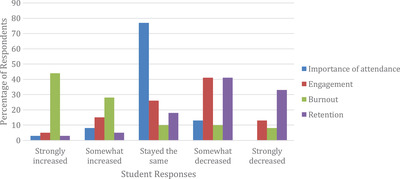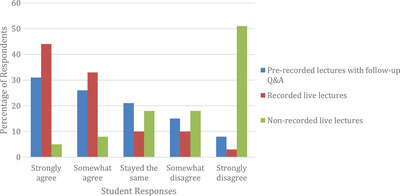1. PROBLEM
In March 2020, the COVID‐19 pandemic necessitated the immediate closure of in‐person dental education to comply with social regulations. Dental schools faced the challenge of effectively engaging students over virtual learning platforms. 1 , 2
Historically, there have been 2 approaches to distance learning: synchronous and asynchronous. Synchronous learning involves students learning together in live environments like lectures, which allows greater engagement and sense of community at the cost of scheduling and technological issues. Conversely, asynchronous learning allows students to learn material on their own and discuss it together in forums like emails or discussion boards, which provides time for material synthesis at the cost of community engagement. 3 , 4
Initially, the Harvard School of Dental Medicine decided to continue virtual learning via a synchronous, live lecture format. However, students perceived their dental education worsening with the transition to virtual learning, with increased burnout and decreased retention and engagement in course material.
2. SOLUTION
To address this concern, faculty decided to augment live lectures by recording them for students to utilize later for review. 5 By recording lectures, faculty addressed technological and pacing issues and improved student retention during longer class sessions.
To evaluate students’ perceptions and preferences with recorded lectures and other course formats, course directors used live Zoom (Zoom Video Communications, San Jose, CA, USA) polling during an optional postcourse feedback session, which allowed students to anonymously complete a multiple‐choice questionnaire. The entire class of 39 second‐year students who completed a course in the treatment of active disease, which emphasized operative dentistry and periodontics, voluntarily responded to the poll. Questions about student preferences for distance learning formats and changes in burnout after the virtual shift were asked. Poll answers were reviewed and discussed. Students were then asked to provide general feedback or comments about the course.
3. RESULTS
There was a 100% response rate corresponding to 39 responses. Students reported that overall, their learning has worsened since the move to e‐learning, with 44% of students responding “somewhat worsened” and 26% answering “significantly worsened.” Polling results indicated that since the advent of virtual lectures, burnout increased, student perceptions of attendance stayed the same, and engagement and retention decreased (Figure 1). There was a strong preference for synchronous recorded live lectures and asynchronous prerecorded lectures with synchronous follow‐up sessions compared to nonrecorded live lectures (Figure 2). Unexpectedly, the poll revealed that students may be similarly comfortable participating during recorded lectures as nonrecorded lectures, with around 50% of students responding “very comfortable” for both formats.
FIGURE 1.

Student Shifts in Perception Since Virtual Classes
FIGURE 2.

Student Preferences of Virtual Class Formats
There were some notable themes during the verbal feedback segment. Students felt that more interactive virtual classes, like question and answer sessions and case‐based small group discussions, would improve engagement and decrease burnout. Several students suggested implementing ungraded quizzes during lectures to promote understanding and engagement. Further student comments can be found in Table 1. Overall, students felt that learning formats like flipped classrooms and creative uses of technology would be beneficial to their virtual learning. Combining synchronous and asynchronous components of distance education may improve student learning for future courses held online.
TABLE 1.
Student comments and suggestions during verbal feedback session
| Comments | Suggestions |
|---|---|
|
|
ACKNOWLEDGMENTS
We thank the HSDM Class of 2022 and faculty for their participation in virtual classes and feedback sessions. We specifically thank Dr. Thomas Nguyen for his hard work as course codirector and Adrien Doherty for his assistance in implementing the virtual classes.
Chen E, Kaczmarek K, Ohyama H. Student perceptions of distance learning strategies during COVID‐19. J Dent Educ. 2021;85(Suppl. 1):1190–1191. 10.1002/jdd.12339
REFERENCES
- 1. Iyer P, Aziz K, Ojcius DM. Impact of COVID‐19 on dental education in the United States. J Dent Educ. 2020;84(6):718‐22. [DOI] [PubMed] [Google Scholar]
- 2. Desai BK. Clinical implications of the COVID‐19 pandemic on dental education. J Dent Educ. 2020;84(5):512. [DOI] [PMC free article] [PubMed] [Google Scholar]
- 3. Watts L. Synchronous and asynchronous communication in distance learning: a review of the literature. Q Rev Distance Educ. 2016;17(1):23‐32,56. [Google Scholar]
- 4. Offir B, Lev Y, Bezalel R. Surface and deep learning processes in distance education: synchronous versus asynchronous systems. Comput Educ. 2008;51(3):1172‐1183. [Google Scholar]
- 5. Rules and Best Practices for the Recording of Classroom Sessions Conducted via Zoom. Harvard University Information Technology Web site . https://harvard.service-now.com/ithelp?id=kb_article&sys_id=6880408bdbab8c9430ed1dca489619bc. Accessed March 21, 2020.


